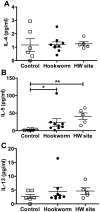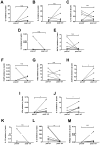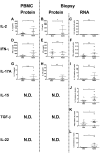Characterising the mucosal and systemic immune responses to experimental human hookworm infection
- PMID: 22346753
- PMCID: PMC3276555
- DOI: 10.1371/journal.ppat.1002520
Characterising the mucosal and systemic immune responses to experimental human hookworm infection
Abstract
The mucosal cytokine response of healthy humans to parasitic helminths has never been reported. We investigated the systemic and mucosal cytokine responses to hookworm infection in experimentally infected, previously hookworm naive individuals from non-endemic areas. We collected both peripheral blood and duodenal biopsies to assess the systemic immune response, as well as the response at the site of adult worm establishment. Our results show that experimental hookworm infection leads to a strong systemic and mucosal Th2 (IL-4, IL-5, IL-9 and IL-13) and regulatory (IL-10 and TGF-β) response, with some evidence of a Th1 (IFN-γ and IL-2) response. Despite upregulation after patency of both IL-15 and ALDH1A2, a known Th17-inducing combination in inflammatory diseases, we saw no evidence of a Th17 (IL-17) response. Moreover, we observed strong suppression of mucosal IL-23 and upregulation of IL-22 during established hookworm infection, suggesting a potential mechanism by which Th17 responses are suppressed, and highlighting the potential that hookworms and their secreted proteins offer as therapeutics for human inflammatory diseases.
Conflict of interest statement
The authors have declared that no competing interests exist.
Figures






References
-
- Hotez PJ, Brooker S, Bethony JM, Bottazzi ME, Loukas A, et al. Hookworm infection. N Engl J Med. 2004;351:799–807. - PubMed
-
- Hotez PJ, Bethony JM, Diemert DJ, Pearson M, Loukas A. Developing vaccines to combat hookworm infection and intestinal schistosomiasis. Nat Rev Microbiol. 2010;8:814–826. - PubMed
-
- Blount D, Hooi D, Feary J, Venn A, Telford G, et al. Immunologic profiles of persons recruited for a randomized, placebo-controlled clinical trial of hookworm infection. Am J Trop Med Hyg. 2009;81:911–916. - PubMed
Publication types
MeSH terms
Substances
LinkOut - more resources
Full Text Sources
Other Literature Sources

